Introduction
Since 1992, the Sociedad Científica Médico Estudiantil Peruana - SOCIMEP (Peruvian Medical Student Scientific Society) has been holding the National Scientific Congress (NSC) every year1,2 with the aim of promoting research activities among Peruvian medical students and, thus, contribute to the improvement of the training of future Peruvian physicians.3
However, the percentage of papers that are published in scientific journals after being presented at the NSC does not exceed 10%,4 and the publication rate of papers presented in the last 10 editions is uncertain because it is necessary to await several years to correctly evaluate this indicator. Furthermore, the factors that may influence the publication of these papers are not clearly defined.
Worldwide, most studies evaluating the publication rate of medical research papers after their submission to a congress or similar academic events have been carried out using data from papers submitted by specialty doctors,5-7 which is the reason why data on the scientific publication of papers by medical students are limited, especially in Latin America. Notwithstanding the above, there are some studies that have described the publication rate among medical students in countries of the region, such as Cuba8, Colombia,9 and Paraguay.10
In view of the foregoing, the objectives of the present study were to determine the publication rate of research papers submitted to the NSC between 2010 and 2014 in indexed scientific journals, as well as the factors associated with their publication, and to describe the characteristics of the papers published.
Materials and methods
Type of study and sample
Retrospective study. All abstracts of research papers submitted by Peruvian medical students to the NSC editions held between 2010 and 2014 were included. Abstracts of clinical cases, research projects and research papers submitted by students with a foreign affiliation (i.e., a non-Peruvian university) were excluded, resulting in the analysis of 407 abstracts.
In order to correctly determine the publication rate, a waiting time (follow-up) of six years was considered since, according to several studies, this waiting period is necessary to properly evaluate this indicator.11-13 In other words, if the scientific production of 2014 is to be evaluated, it is necessary to wait until 2020.
Procedures
Information on the research papers was extracted from the abstract books of each congress. To access these abstract books, e-mails were sent to the members of the organizing committees of each NSC and to the SOCIMEP advisors: the 2010, 2012 and 2013 abstract books were provided by a SOCIMEP advisor, the 2011 book was available online, and the 2014 book was obtained through a member of the 2014 NSC organizing committee. Moreover, in order to ensure the replicability of the study, the abstract books were deposited in an academic repository (link available in the ethical considerations section).
Once the abstracts were available, a data collection template was created in Microsoft Excel in which the variables considered in the study were included, as well as their coding. Moreover, periodic virtual meetings were held in which all the authors of the study defined the parameters for filling out the template in a standardized manner.
To determine whether a research paper had been published during the follow-up period, a duplicate publication detection strategy14 that has been used in similar studies was used.13,15 This strategy consists of entering the title or key words of the study (variables, place, subjects, and population) in Spanish along with the authors' surnames in the Google Scholar search engine and then repeating the procedure in English. In addition, three authors (CAC, KGM, and YGM) verified that the research work had been published in a scientific journal.
Publication of the research work in a scientific journal during the six years following its submission to the NSC was defined as the outcome variable. Two categories were established for this variable: yes and no.
Moreover, the year of submission of the research paper to the NSC (2010, 2011, 2012, 2013, 2014), the number of authors, the sex of the first author (male, female), the number of advisors with research experience who were involved in or assisted the students in conducting the research (no advisor, one advisor, two or more advisors), the type of university of the principal author (public, private), university location (province, city of Lima), study design (descriptive, analytic observational, experimental), study type (single-center, multicenter, other), and study population (students, hospital patients, people in the community, laboratory animals/cell lines) were included as exposure variables.
Also, in the case of research papers that were published in scientific journals, the following data were recorded: name of the scientific journal in which it was published, median time between submission of the paper to the NSC and submission of the article to the journal (in months), median time between submission of the research paper to the NSC and publication of the article (in months), the database in which the journal was indexed (Latindex, SciELO, Scopus, Web of Science), inclusion of advisor(s) with research experience in the list of authors (yes, no), country of the journal (Peru, foreign), language of publication of the article (Spanish, English), and type of access to the article (open, closed).
Statistical analysis
Statistical analysis of the data was performed in the STATA/MP software, version 16 (StataCorp LLC, Texas, USA). Categorical variables are described using absolute frequencies and percentages, while quantitative variables are described using medians and interquartile ranges (IQR), since the distribution of the data was asymmetric (determined through the visualization of a histogram and the Shapiro-Wilk test). In addition, a bivariate analysis was performed to assess the association between the variables considered and the publication of papers in scientific journals using the chi-square and Mann-Whitney U tests for categorical and quantitative variables, respectively, with a significance level of p<0.05.
Then, to determine the factors associated with the publication of research papers, a multivariate analysis was performed using crude and adjusted Poisson regression models, with logarithmic link function and robust standard errors, in which relative risk (RR) values were calculated with their respective 95% confidence intervals (95%CI). The adjusted regression model included variables with statistical significance in the bivariate analysis (p<0.05); moreover, variables that have been associated with the publication of this type of work in scientific journals in similar studies were also included, such as the type of university,4 the location of the university,15 and the design of the study.13 Multicollinearity was considered to exist if the variance inflation factor (VIF) was >10 or the maximum condition number was >30.16 Finally, Kaplan-Meier survival curves17 were constructed to plot the time to publication of the study according to the year of submission to the NSC.
Ethical considerations
Data management in this research conforms to the requirements of Guideline 22 (Use of Data Obtained from the Online Environment and Digital Tools in Health-Related Research) stipulated in the International Ethical Guidelines for Health-Related Research Involving Humans issued by the Council for International Organizations of Medical Sciences (CIOMS).18 Data are publicly available, and therefore approval by an institutional ethics committee was not required. The abstract books used in this research are available to anyone who wishes to read them at https://doi.org/10.6084/m9.figshare.14024738.v1.
Results
The year with the highest number of abstracts submitted to the NSC was 2011 (26.54%). The median number of authors per research paper was 5 (IQR: 3-7) and the percentage of papers in which the first author was male was slightly higher (58.23%). One or more advisors with research experience participated in 82.55% of the papers, and 61.67% of the authors came from a university outside Lima. Descriptive design and student population were the most frequent study design and population (54.05% and 30.47%); moreover, most studies were single-center (81.08%) (Table 1). During the study period, 97 papers were published, i.e., 23.83% (95%CI: 19.93%-28.23%) of the total number of papers submitted to the NSCs held between 2010 and 2014.
Table 1 Characteristics of the research papers submitted by Peruvian medical students to the 2010 to 2014 editions of the National Scientific Congress (n=407).
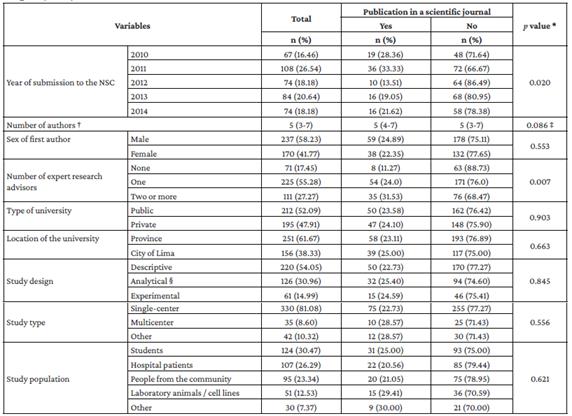
NSC: National Scientific Congress.
* Chi-square test;
† median and interquartile range;
‡ Mann-Whitney U test;
§ observational analytical.
Source: Own elaboration.
In the bivariate analysis, the year of submission of the paper to the NSC was significantly associated with publication (p=0.020), the percentage of publication being higher in 2010 and 2011 (>25%) compared to 2012, 2013, and 2014 (<25%). Likewise, the number of advisors with research experience who participated in the research was associated with publication (p=0.007), with an increased frequency of publication in papers in which two or more advisors were involved. No significant differences were observed for the other variables (Table 1).
In the crude Poisson regression model, associations in the bivariate analysis were unchanged, and it was found that papers submitted to the 2012 and 2013 editions of the congress were less likely to be published compared to those submitted in 2011 (category with the maximum number of observations) (RR=0.40, 95%CI: 0.21-0.57 and RR=0.57, 95%CI: 0.34-0.96, respectively). Likewise, in the adjusted model, papers in which an advisor or two or more advisors with research experience participated were 2.19 and 2.61 times, respectively, more likely to be published in a scientific journal compared to those without an advisor (aRR=2.19, 95%CI: 1.10-4.36 and aRR=2.61, 95%CI: 1.28-5.33) (Table 2). Finally, no evidence of multicollinearity was found as the VIF was <10 and the maximum number of condition was <30.
Table 2 Multivariate analysis results. Crude and adjusted Poisson regression models.
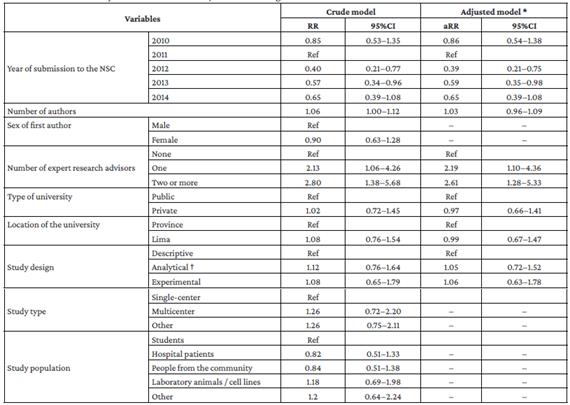
NSC: National Scientific Congress; RR: relative risk; 95%CI: 95% confidence intervals; Ref: reference category.
* Adjusted for year of submission of the research paper to the congress, number of authors, number of advisors, type of university, location of the university, and study design.
† Analytical observational.
Source: Own elaboration.
Regarding the characteristics of the 97 studies that were published, it was found that 96.91%, 72.16% and 43.30% were published in Spanish, in Peruvian journals, and in journals indexed in Latindex, respectively, and that the Revista del Cuerpo Médico del Hospital Nacional Almanzor Aguinaga Asenjo was the journal in which the largest number of these papers were published (26.80%). In addition, the advisor or advisors with research experience were included as an author in 77.32%, and the median time from submission to the congress until the article was submitted to the journal and until its publication was 10 (IQR: 2-20) and 14 months (IQR: 5-23) (Table 3).
Table 3 Characteristics of research papers written by Peruvian medical students that were published in a scientific journal after their submission to the National Scientific Congress between 2010 and 2014 (n=97).
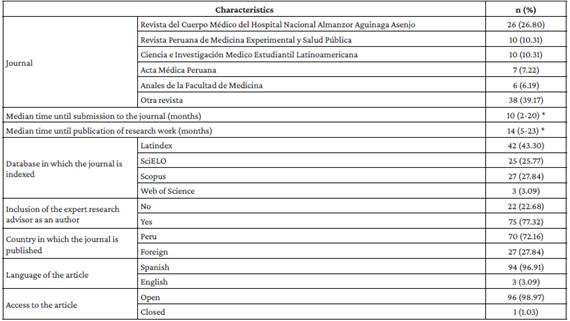
* Median and interquartile range.
Source: Own elaboration.
On the other hand, Figure 1 shows the publication rates by year of submission of the research paper to the NSC, where significant variations in these rates are observed during the six years of follow-up. While publication rates in 2010 and 2011 were above 30%, they were below 25% in 2013 and 2014, and below 20% in 2012.
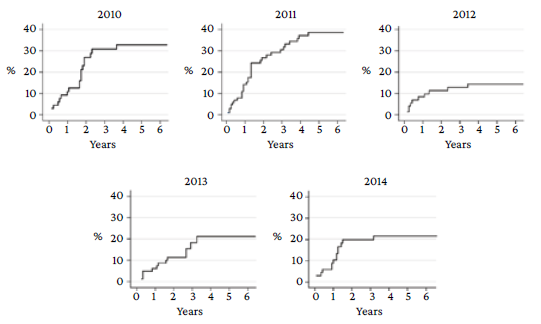
Source: Own elaboration.
Figure 1 Variation in the publication rate of research papers during the six years following their submission to the 2010-2014 editions of the National Scientific Congress.
Figure 2 shows the distribution of research papers published during the six years of follow-up, where it is observed that the maximum time required for publication in a scientific journal was 4.2 years, which occurred in 2011. However, in the first three years of the follow-up period, 88.7% of the papers had already been published. This figure also shows that some studies were published prior to their submission to the NSC.
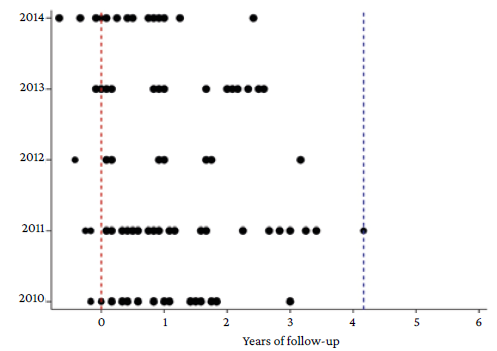
Source: Own elaboration.
Figure 2 Distribution of research publication during a six-year follow-up period. The red line indicates the moment when the National Scientific Congress was held. Note that some points are located before the red line, indicating that the study was published before submission to the NSC. The blue line indicates the maximum time of 4.2 years until publication of the research paper in a scientific journal.
Discussion
The main findings of the present study include: i) 23.83% of the research papers submitted to the NSCs held between 2010 and 2014 were published in a scientific journal; ii) there was a reduction in the publication rate in recent years (2013-2014), albeit with a slight increase in the last year; iii) the participation of one or two or more advisors with research experience was a factor significantly associated with the publication of the research work in a scientific journal; and iv) a high percentage of the studies were published in journals indexed in Latindex (43.30%).
Regarding publication rate, the 23.83% found in the present study is higher than the 9.8% described by Toro-Polo et al.4 in their study conducted in the same population, but which included abstracts submitted between 2002 and 2009 (n=532), and the 10.6% reported by Valladares Garrido et al.19 in a study in which research papers submitted to international scientific congresses by Latin American medical students between 2011 and 2014 (n=783) were analyzed. However, it should be noted that the latter study was conducted in 2015 (i.e., only one year after the end of the study period), so it is considered that there was not enough follow-up time to correctly measure this indicator.
The aforementioned figure is also higher than the 10.34% reported by Ortiz-Martínez et al.9 in a study that included abstracts submitted to the 2014 and 2015 editions of the Colombian Student Congress of Medical Research (n=87) and the 11.55% described by Corrales-Reyes et al.8 in a research in which papers submitted to the 2016 and 2017 Cuban medical science student forums were analyzed (n=537). However, it is lower than the 46.34% found by Aquino-Canchari et al.20 in a study that evaluated the publication rate of research papers submitted between 2014 and 2018 to the NSCs and that were rated as "top ten" in each edition (n=41), although this difference may be attributable both to the sample size of the Aquino-Canchari et al.20 study and to the fact that in that study only papers chosen as the best in each edition of the congress were taken into account.
Notwithstanding the above, it should be pointed out that the publication rate of papers submitted to the NSC in 2012 and 2013 was <20%, although a slight increase was observed in 2014 (21.62%). In this sense, while the publication rate reported here is substantial (23.83%), it is still lower than the publication rates of research submitted to specialized medical congresses, which exceed 35%.21-24
According to the results of the multivariate analysis, the involvement of an advisor with research experience was a major factor for the publication of the study in a scientific journal (RR=2.19, 95%CI: 1.10-4.36), increasing the probability of publication when two or more advisors participated (RR=2.61, 95%CI: 1.28-5.33), which is consistent with the relevant literature, as similar studies have reported that the inclusion of an advisor in the research work is a factor associated with publication in scientific journals.19,25,26 It is worth highlighting that students prefer to choose as their advisor a professor who continually conducts research and publishes their findings.27 For this reason, the participation of one or more advisors with research experience in the work submitted to the NSCs should be encouraged, since such an advisor could also take on the role of research supervisor28 and ensure compliance with ethical guidelines in research.29
Another significant finding of the present study was that a high proportion of the papers (43.30%) were published in journals that were only indexed in Latindex, which implies a lower visibility and probably a lower impact than that of studies published in journals indexed in databases such as Scopus or Web of Science. In this regard, it is not known whether the authors of these papers first submitted them to journals indexed in the latter two databases and, if the article was rejected, proceeded to submit it to journals with a lower level of indexing. In view of the above, further studies on this topic are recommended to inquire into the publication preferences of Peruvian medical students.
The median time elapsed from submission of the research to the NSC to publication of the study in a scientific journal was 14 months. In this respect, studies on research conducted by specialty doctors have reported slightly longer publication times,5,7,23,30 although with higher publication rates. This suggests that Peruvian medical students publish their research papers in periods similar to those described for specialty doctors, which is a positive indicator of scientific productivity in this population.
Finally, one important point to note is that some research papers were submitted to the NSC after being published in a scientific journal. This situation has also been described in similar events, such as the annual meetings of the Canadian Society of Otolaryngology-Head & Neck Surgery, where 6.6% of the studies had already been published prior to their submission to the congress.31 On this matter, NSC regulations state that this conduct is not allowed, thus this is a serious ethical problem that was not detected at the time of submission.
The present study has several limitations that should be addressed. First, other factors such as the students' study cycle or academic performance that could be related to the publication of the research paper were not evaluated because these data were not available in the abstract books, so further studies should include interviews with the authors in order to determine these factors more accurately. Second, publication bias was not analyzed, and this could be an important factor for the publication of the work, as described in other studies.32 Third, no information was collected on the citations of published research papers, which would have been useful for measuring their impact factor, although this would require a new follow-up period. Fourth, the information available in the abstract books was not recorded in a homogeneous format, showing variations in each edition of the NSC and making data collection difficult.
Conclusions
Almost a quarter of the papers submitted to the NSCs were published in a scientific journal; although there was an increase in the publication rate compared to previous reports, it was not constant in the years studied. The involvement of an advisor or more advisors with research experience was significantly associated with publication, considerably increasing the probability of publication, so it is recommended to promote their participation in studies submitted to the NSC.
Based on the findings of the present study, further studies should evaluate the annual impact of NSCs based on the number of research papers published in scientific journals during a follow-up period of up to four and a half years. Likewise, the abstract books of the congress should have a homogeneous format for recording the information, as this would facilitate future bibliometric studies on this event.















